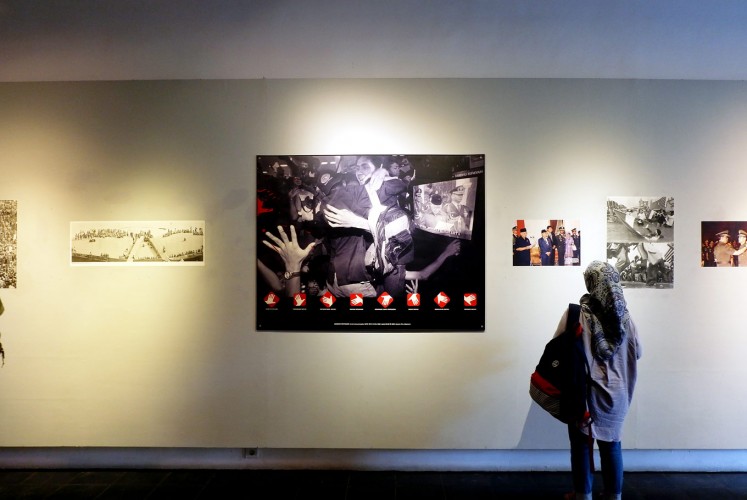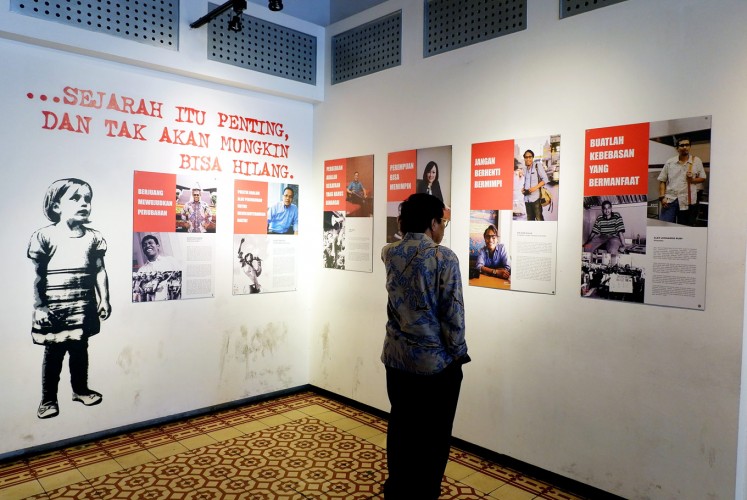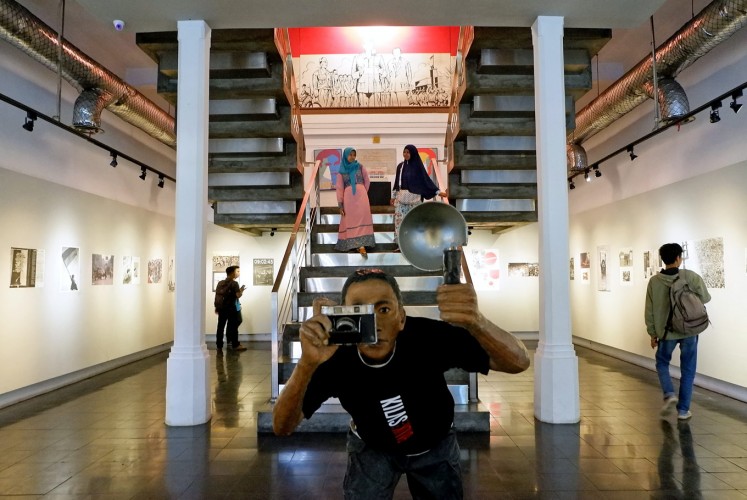Popular Reads
Top Results
Can't find what you're looking for?
View all search resultsPopular Reads
Top Results
Can't find what you're looking for?
View all search resultsA grim reminder of the dark history of 'Reformasi'
A photo exhibition that commemorates 20 years of Reformasi raises an unanswered question: Have victims of past human rights violations received justice after all these years?
Change text size
Gift Premium Articles
to Anyone
I
n 1998, Indonesian authorities shot dead four Trisakti University students during a protest that demanded economic and political reform.
The deaths of the students started a movement known as reformasi era, which later ended in the historic downfall of dictator Soeharto’s authoritarian New Order regime on May 21.
The Antara Photojournalism Gallery in Jakarta is displaying the portraits of the four students — Hafidhin Royan, Elang Mulya Lesmana, Hery Hartanto and Hendriawan Sie — to pay tribute to them in a big frame in front of its iconic photojournalist statue.
The gallery also showcases Kompas newspaper photojournalist Julian Sihombing’s photo titled Pejuang Reformasi Dimakamkan (The Burial of Reformasi’s Fallen Heroes), which depicts university students lifting the biers carrying Elang and Hery at Tanah Kusir public cemetery in Jakarta on May 13, 1998 to pay their last respects.
Next to Julian’s photo is a photo of broken glass with a bullet hole in it, taken by photojournalist Rully Kesuma at the Trisakti campus during a bloody riot that happened after the death of its students. The wide crack in the glass is evidence of how tragic the riot was and how the Indonesian government decided to use real bullets against unarmed students trapped on their campus.
At the gallery, other must-see images are Beawiharta’s photo of university students fiercely battling against a soldier, Alex Lumi’s photo of president Soeharto reading his resignation letter and Budhi Yogaswara’s photo of Prabowo Subianto removed from his position as the Army Strategic Reserves Command (Kostrad) chief.
Those are just some of more than 85 photos displayed during a photo exhibition titled “20 Tahun Reformasi: Segenggam Refleksi” (20 Years of Reformation: A Handful of Reflections) at the gallery from May 11 to June 11.
“This exhibition aims to prevent the spirit of the movement that managed to overthrow the powerful New Order regime from fading away amid today’s endless drama of our shallow and childish politicians,” said the exhibition’s curator, Oscar Matuloh.
Now and then: A visitor looks at photos of 1998 activists at Antara Photojournalism Gallery in Jakarta. (JP/A. Kurniawan Ulung)Through the exhibition, visitors, especially the ones who were too young or who had not been born during reformasi, are expected to have a better understanding about what happened 20 years ago. Therefore, they will realize that lives had been sacrificed for the freedom they enjoy today.
The exhibition also displays portraits of several activists who were directly involved in reformasi. One of them is Komala Sari, who is now an executive assistant for a CEO in a company.
In 1998, she was a student of LPK Tarakanita and also a field coordinator of the student movement.
A photograph of Komala depicts her wearing a hat, a T-shirt and jeans with a microphone hanging over her shoulder as she gives instructions to a group of demonstrators she was leading.
“I took the chance to prove that women could also lead,” she said.
Like Komala, Fadil Anwar Syarifudin from the Chinese-Indonesian Literature Museum also took to the streets 20 years ago.
“In 1998, my friends and I were witnesses to the killings of Chinese-Indonesians. In Karawaci [in Tangerang], we helped remove their corpses,” he said.
Read also: There is hope for peaceful diversity: The Chinese Indonesian Literature Museum
He said after 20 years, the goal of reformasi had yet to be achieved because sectarian or racial issues still occur today, as well as occasional religious discrimination.
Although the country’s economy appears to be on the move after the fall of Soeharto, no one person or institution has taken responsibility for the fatal shootings.
Until now, there has been no official investigation or recognition of who gave the order to Indonesian authorities, particularly the soldiers at that time, to start shooting students and civilians with live rounds.
Like the Trisakti shootings, other past human rights violations, such as the Semanggi shootings and the May 1998 riots that led to looting, fire and mass rape, mostly of Chinese-Indonesians, are still unsolved after 20 years.
The government claims they are facing legal hurdles in solving the cases, but it is still trying to find a way to propose reconciliation.
The reconciliation offer has raised the eyebrows of human rights activists and the victims’ family members, who still demand a full investigation of the 1998 human rights violations for the sake of justice.














